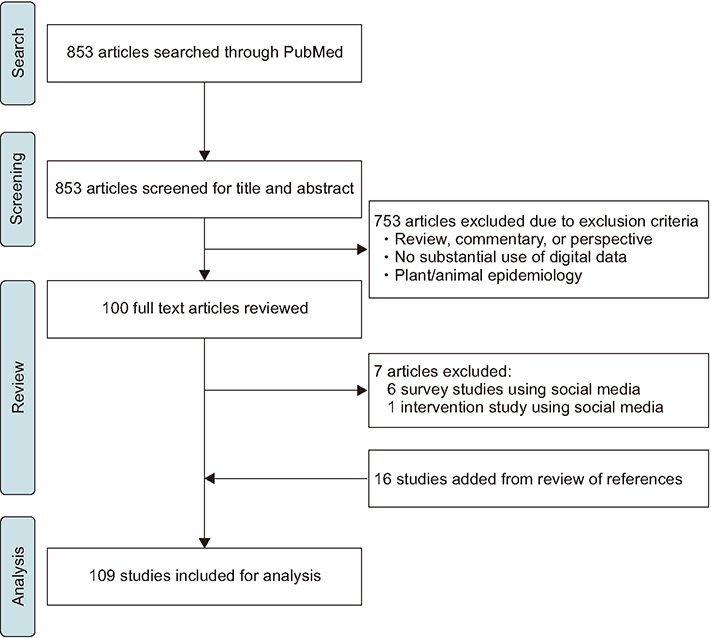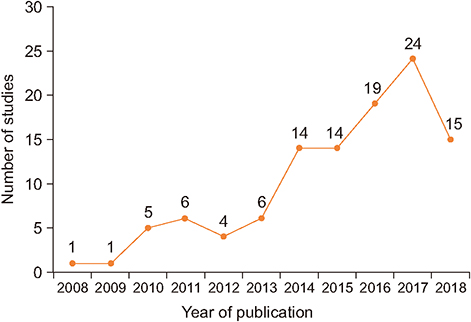Healthc Inform Res.
2018 Oct;24(4):253-262. 10.4258/hir.2018.24.4.253.
Digital Epidemiology: Use of Digital Data Collected for Non-epidemiological Purposes in Epidemiological Studies
- Affiliations
-
- 1College of Nursing, Seoul National University, Seoul, Korea. soledad7@snu.ac.kr
- KMID: 2434540
- DOI: http://doi.org/10.4258/hir.2018.24.4.253
Abstract
OBJECTIVES
We reviewed digital epidemiological studies to characterize how researchers are using digital data by topic domain, study purpose, data source, and analytic method.
METHODS
We reviewed research articles published within the last decade that used digital data to answer epidemiological research questions. Data were abstracted from these articles using a data collection tool that we developed. Finally, we summarized the characteristics of the digital epidemiological studies.
RESULTS
We identified six main topic domains: infectious diseases (58.7%), non-communicable diseases (29.4%), mental health and substance use (8.3%), general population behavior (4.6%), environmental, dietary, and lifestyle (4.6%), and vital status (0.9%). We identified four categories for the study purpose: description (22.9%), exploration (34.9%), explanation (27.5%), and prediction and control (14.7%). We identified eight categories for the data sources: web search query (52.3%), social media posts (31.2%), web portal posts (11.9%), webpage access logs (7.3%), images (7.3%), mobile phone network data (1.8%), global positioning system data (1.8%), and others (2.8%). Of these, 50.5% used correlation analyses, 41.3% regression analyses, 25.6% machine learning, and 19.3% descriptive analyses.
CONCLUSIONS
Digital data collected for non-epidemiological purposes are being used to study health phenomena in a variety of topic domains. Digital epidemiology requires access to large datasets and advanced analytics. Ensuring open access is clearly at odds with the desire to have as little personal data as possible in these large datasets to protect privacy. Establishment of data cooperatives with restricted access may be a solution to this dilemma.
Keyword
MeSH Terms
Figure
Reference
-
1. Eckhoff PA, Tatem AJ. Digital methods in epidemiology can transform disease control. Int Health. 2015; 7(2):77–78.
Article2. Salathe M. Digital epidemiology: what is it, and where is it going? Life Sci Soc Policy. 2018; 14(1):1.
Article3. Ginsberg J, Mohebbi MH, Patel RS, Brammer L, Smolinski MS, Brilliant L. Detecting influenza epidemics using search engine query data. Nature. 2009; 457(7232):1012–1014.
Article4. Nuti SV, Wayda B, Ranasinghe I, Wang S, Dreyer RP, Chen SI, et al. The use of google trends in health care research: a systematic review. PLoS One. 2014; 9(10):e109583.
Article5. Lazer D, Kennedy R, King G, Vespignani A. Big data: the parable of Google Flu: traps in big data analysis. Science. 2014; 343(6176):1203–1205.
Article6. Signorini A, Segre AM, Polgreen PM. The use of Twitter to track levels of disease activity and public concern in the U.S. during the influenza A H1N1 pandemic. PLoS One. 2011; 6(5):e19467.
Article7. Salathe M, Khandelwal S. Assessing vaccination sentiments with online social media: implications for infectious disease dynamics and control. PLoS Comput Biol. 2011; 7(10):e1002199.
Article8. Freifeld CC, Brownstein JS, Menone CM, Bao W, Filice R, Kass-Hout T, et al. Digital drug safety surveillance: monitoring pharmaceutical products in twitter. Drug Saf. 2014; 37(5):343–350.
Article9. McIver DJ, Brownstein JS. Wikipedia usage estimates prevalence of influenza-like illness in the United States in near real-time. PLoS Comput Biol. 2014; 10(4):e1003581.
Article10. Wesolowski A, Eagle N, Tatem AJ, Smith DL, Noor AM, Snow RW, et al. Quantifying the impact of human mobility on malaria. Science. 2012; 338(6104):267–270.
Article11. Bengtsson L, Lu X, Thorson A, Garfield R, von Schreeb J. Improved response to disasters and outbreaks by tracking population movements with mobile phone network data: a post-earthquake geospatial study in Haiti. PLoS Med. 2011; 8(8):e1001083.
Article12. Zaccai JH. How to assess epidemiological studies. Postgrad Med J. 2004; 80(941):140–147.
Article13. Polit DF, Beck CT. Nursing research: generating and assessing evidence for nursing practice. 10th ed. Philadelphia (PA): Lippincott Williams & Wilkins;2017.14. Sylvestre E, Bouzille G, Breton M, Cuggia M, Campillo-Gimenez B. Retrieving the vital status of patients with cancer using online obituaries. Stud Health Technol Inform. 2018; 247:571–575.15. Tourassi G, Yoon HJ, Xu S, Han X. The utility of web mining for epidemiological research: studying the association between parity and cancer risk. J Am Med Inform Assoc. 2016; 23(3):588–595.
Article16. Edoh T. Risk prevention of spreading emerging infectious diseases using a hybridcrowdsensing paradigm, optical sensors, and smartphone. J Med Syst. 2018; 42(5):91.
Article17. Moon RJ, Curtis EM, Davies JH, Cooper C, Harvey NC. Seasonal variation in Internet searches for vitamin D. Arch Osteoporos. 2017; 12(1):28.
Article18. Chary M, Genes N, Giraud-Carrier C, Hanson C, Nelson LS, Manini AF. Epidemiology from Tweets: estimating misuse of prescription opioids in the USA from social media. J Med Toxicol. 2017; 13(4):278–286.
Article19. Towers S, Afzal S, Bernal G, Bliss N, Brown S, Espinoza B, et al. Mass media and the contagion of fear: the case of Ebola in America. PLoS One. 2015; 10(6):e0129179.
Article20. Ram S, Zhang W, Williams M, Pengetnze Y. Predicting asthma-related emergency department visits using big data. IEEE J Biomed Health Inform. 2015; 19(4):1216–1223.
Article21. Zhang X, Dang S, Ji F, Shi J, Li Y, Li M, et al. Seasonality of cellulitis: evidence from Google Trends. Infect Drug Resist. 2018; 11:689–693.
Article22. Miller M, Banerjee T, Muppalla R, Romine W, Sheth A. What are people tweeting about Zika? An exploratory study concerning its symptoms, treatment, transmission, and prevention. JMIR Public Health Surveill. 2017; 3(2):e38.
Article23. Phillips CA, Barz Leahy A, Li Y, Schapira MM, Bailey LC, Merchant RM. Relationship between state-level Google online search volume and cancer incidence in the United States: retrospective study. J Med Internet Res. 2018; 20(1):e6.
Article24. McGough SF, Brownstein JS, Hawkins JB, Santillana M. Forecasting Zika incidence in the 2016 Latin America outbreak combining traditional disease surveillance with search, social media, and news report data. PLoS Negl Trop Dis. 2017; 11(1):e0005295.
Article25. Generous N, Fairchild G, Deshpande A, Del Valle SY, Priedhorsky R. Global disease monitoring and forecasting with Wikipedia. PLoS Comput Biol. 2014; 10(11):e1003892.
Article26. Adrover C, Bodnar T, Huang Z, Telenti A, Salathe M. Identifying adverse effects of HIV drug treatment and associated sentiments using Twitter. JMIR Public Health Surveill. 2015; 1(2):e7.
Article27. Nsoesie EO, Buckeridge DL, Brownstein JS. Guess who's not coming to dinner? Evaluating online restaurant reservations for disease surveillance. J Med Internet Res. 2014; 16(1):e22.
Article28. Valson JS, Soman B. Spatiotemporal clustering of dengue cases in Thiruvananthapuram district, Kerala. Indian J Public Health. 2017; 61(2):74–80.29. Park SE, Tang L, Bie B, Zhi D. All pins are not created equal communicating skin cancer visually on Pinterest. Transl Behav Med. 2018; 04. 17. [Epub]. DOI: 10.1093/tbm/iby044.
Article30. Dettori M, Arru B, Azara A, Piana A, Mariotti G, Camerada MV, et al. In the digital era, is community outrage a feasible proxy indicator of emotional epidemiology? The case of meningococcal disease in Sardinia, Italy. Int J Environ Res Public Health. 2018; 15(7):E1512.
Article31. Roche B, Gaillard B, Leger L, Pelagie-Moutenda R, Sochacki T, Cazelles B, et al. An ecological and digital epidemiology analysis on the role of human behavior on the 2014 Chikungunya outbreak in Martinique. Sci Rep. 2017; 7(1):5967.
Article32. Pollett S, Boscardin WJ, Azziz-Baumgartner E, Tinoco YO, Soto G, Romero C, et al. Evaluating Google Flu Trends in Latin America: important lessons for the next phase of digital disease detection. Clin Infect Dis. 2017; 64(1):34–41.
Article33. Hossain N, Househ M. Using HealthMap to analyse Middle East Respiratory Syndrome (MERS) data. Stud Health Technol Inform. 2016; 226:213–216.
- Full Text Links
- Actions
-
Cited
- CITED
-
- Close
- Share
- Similar articles
-
- Digital Biomarkers for Alzheimer’s Disease
- Preparing for a New World: Making Friends with Digital Health
- The Review of Epidemiological investigation of Leprosy by Using Polymerase Chain Reaction
- Anatomic Variation of the Common Palmar Digital Nerves and Arteries
- Application of Epidemiology to the Tobacco Lawsuit Cases in KOREA




